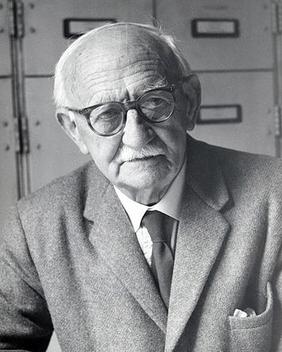John Hutchinson (botanist) facts for kids
Quick facts for kids
John Hutchinson
|
|
|---|---|
 |
|
| Born | 7 April 1884 Wark on Tyne, Northumberland
|
| Died | 2 September 1972 (aged 88) |
| Known for | Hutchinson system |
| Awards | Fellow of the Royal Society (1947) Darwin-Wallace Medal (Silver, 1958) Linnean Medal (1965) |
| Scientific career | |
| Fields | Botany |
| Author abbrev. (botany) | Hutch. |
John Hutchinson, born on April 7, 1884, in Blindburn, Northumberland, England, was a famous English botanist and taxonomist. A botanist studies plants, and a taxonomist specializes in classifying living things into groups. He spent his life studying plants and how they are related to each other. He passed away in London on September 2, 1972.
Contents
Discovering the World of Plants
John Hutchinson started his journey with plants by training in gardening in Northumberland and Durham. In 1904, he became a student gardener at the famous Kew Gardens in London.
His amazing skills in identifying and drawing plants were quickly noticed. Because of this, he was given a job at the Herbarium in 1905. A herbarium is like a library for dried plant specimens. He worked in different sections, focusing on plants from India and then Tropical Africa. From 1936, he was in charge of the Botany Museums at Kew.
He retired in 1948 but continued his important work. He focused on the phylogeny of flowering plants. Phylogeny is the study of how different groups of organisms are related through evolution. He also published two parts of his major work, The Genera of Flowering Plants.
Hutchinson's Plant Classification System
John Hutchinson came up with a new way to classify angiosperms, which are flowering plants. His system was quite different from the ones used by other famous botanists like Joseph Dalton Hooker and Adolf Engler.
Simply put, Hutchinson suggested that flowering plants could be divided into two main groups:
- Plants that are mostly soft and green, like herbs (herbaceous).
- Plants that are woody, like trees and shrubs.
This new way of thinking helped scientists better understand how flowering plants evolved.
Adventures in South Africa
John Hutchinson went on two long trips to South Africa to collect plants. He wrote all about these adventures in his book A Botanist in Southern Africa.
His first trip was from August 1928 to April 1929. He explored many areas, starting in Cape Town and Table Mountain. He traveled with other botanists, including Neville Stuart Pillans and Rudolf Marloth. He even bought a small car to help him explore! He visited places along the southern Cape coast and traveled inland to areas like Grahamstown. He also went to the far northern Transvaal with General Smuts, who was also a keen botanist. They explored Lake Fundudzi, which is a sacred place for the Venda people.
His second trip was from June to September 1930. This time, he joined a group traveling to Lake Tanganyika in Central Africa. They started from Irene in South Africa and collected plants all the way. After this big journey, he explored the Soutpansberg mountains and the Drakensberg in South Africa. He even climbed to the top of Mont-aux-Sources! These trips helped him collect many new plant specimens for study.
Awards and Recognition
John Hutchinson received many honors for his contributions to botany:
- In 1934, he was given an honorary degree (LL.D.) by the University of St Andrews.
- He received the Veitch Memorial Medal in 1937.
- In 1944, he was awarded the Victoria Medal (horticulture) for his amazing work in horticulture (the art of garden cultivation).
- He received the Linnaean Gold Medal in 1968.
- In 1958, he was awarded the Linnean Society of London's Darwin-Wallace Medal.
- He was made an Honorary Fellow of the Association for Tropical Biology and Conservation (ATBC) in 1965.
- In 1947, he was elected a Fellow of the Royal Society (FRS), which is a very high honor for scientists in the UK.
- He was awarded the O.B.E. (Officer of the Order of the British Empire) shortly before he passed away.
- A genus of plants, Hutchinsonia, was named after him to honor his work.
Personal Life
John Hutchinson was married and had two sons and three daughters. One of his daughters lived in South Africa. In his free time, he loved to travel around the English countryside with his wife in a caravan. They would often draw wild flowers they found.
At his funeral, his colleagues from Kew Gardens sent a special wreath. It was made mostly of South African flowers, showing how much they remembered his adventures there.
Selected Books
John Hutchinson wrote several important books about plants:
- The Families of Flowering Plants: This was a two-volume work, with Volume 1 (1926) covering Dicotyledonae and Volume 2 (1934) covering Monocotyledonae.
- The Genera of Flowering Plants: This was another major work, with volumes published in 1964, 1967, and a third volume after his death.
- Common Wild Flowers (1945)
- More Common Wild Flowers (1948)
- Uncommon Wild Flowers (1950)
- British Wild Flowers (1955)
- The Story of Plants (with R. Melville)
- A Botanist in Southern Africa (1946)
- Flora of West Tropical Africa (with Dr John McEwen Dalziel)
- Evolution and Phylogeny of Flowering Plants (1969)
See also
 In Spanish: John Hutchinson para niños
In Spanish: John Hutchinson para niños
- Hutchinson system

